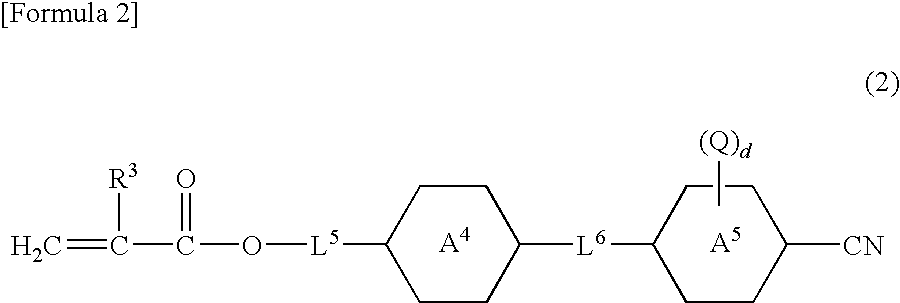Polymerizable composition
a polymer film and composition technology, applied in the field of polymerizable compositions, can solve the problems of insufficient strength or residual stress-induced strain of polymer films, failure to retain film homogeneity, and difficulty in fixing a desired alignment state, etc., to achieve good solvent solubility, good solvent solubility, and good solvent solubility
- Summary
- Abstract
- Description
- Claims
- Application Information
AI Technical Summary
Benefits of technology
Problems solved by technology
Method used
Image
Examples
examples
[0066]The present invention will now be illustrated in greater detail by way of Examples and Comparative Examples, but it should be understood that the invention is not deemed to be limited thereto.
examples 1-1 to 1-4
and Comparative Examples 1-1 to 1-10
[0067]A polymer film was obtained in accordance with the following procedures: [1] preparation of polymerizable composition solution, [2] preparation of substrate, and [3] application to substrate.
[1] Preparation of Polymerizable Composition Solution
[0068]Each of polymerizable compositions having the formulation shown in Table 1 below and weighing 1.0 g was dissolved in 4 g of a solvent (cyclohexanone / 2-butanone=1 / 1 by mass), and 0.03 g of a radical polymerization initiator (N-1919, from ADEKA Corp.) was added and completely dissolved therein. The solution was filtered through a filter with a pore size of 0.45 μm to prepare a polymerizable composition solution.
[2] Preparation of Substrate
[0069]A glass plate was cleaned with a mild detergent, rinsed with pure water, and dried. A 5% aqueous solution of polyvinyl alcohol was uniformly applied to the glass plate with a spin coater and dried at 100° C. for 3 minutes. The polyvinyl alcohol film thus for...
examples 2-1 and 2-2
and Comparative Examples 2-1 and 2-2
[0078]In the same manner as in Example 1, a polymer film was obtained from the polymerizable compositions of which the formulation is indicated in Table 2 and evaluated for film formation stability to confirm a suitable mixing ratio of the bifunctional (meth)acrylate compound and the monofunctional (meth)acrylate compound in the polymerizable composition of the invention. The results obtained are shown in Table 2. For reference, the results of evaluation of film formation stability in Example 1-3 and Comparative Example 1-5 are also shown in Table 2.
PUM
| Property | Measurement | Unit |
|---|---|---|
| temperature | aaaaa | aaaaa |
| temperature | aaaaa | aaaaa |
| boiling point | aaaaa | aaaaa |
Abstract
Description
Claims
Application Information
 Login to View More
Login to View More - R&D
- Intellectual Property
- Life Sciences
- Materials
- Tech Scout
- Unparalleled Data Quality
- Higher Quality Content
- 60% Fewer Hallucinations
Browse by: Latest US Patents, China's latest patents, Technical Efficacy Thesaurus, Application Domain, Technology Topic, Popular Technical Reports.
© 2025 PatSnap. All rights reserved.Legal|Privacy policy|Modern Slavery Act Transparency Statement|Sitemap|About US| Contact US: help@patsnap.com



